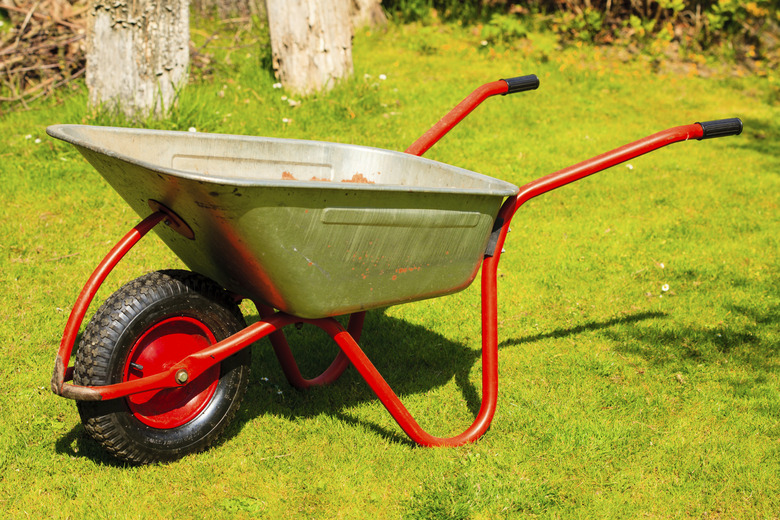What Simple Machines Make A Wheelbarrow?
Wheelbarrows carry more goods from place to place using less force than a person could carry them. In fact, a person would have to make several trips to carry the items by hand. With the help of the wheelbarrow's two simple machines—the lever and the wheel and axle—people can save time during the process of hauling.
Compound Machines
Compound Machines
Wheelbarrows use more than one simple machine to reduce the effort needed to do a job, making them compound machines. Adding extra simple machines spreads the effort and force required to do the job and allow the tool to do more than one job. In this case, the wheelbarrow can lift heavy loads and can move them from one place to another.
Levers
Levers
As a lever, wheelbarrows lift heavy loads while minimizing the effort required. Levers consist of resistance arms, effort arms and a fulcrum. In class 2 levers, like the wheelbarrow, the resistance arm is in the middle between the fulcrum and the effort arm. The wheelbarrow's effort arms are the handles that the person uses to lift up the heavy load in the barrow. The barrow and its heavy load are the resistance arm that push down. The wheel is the fulcrum that allows the wheel barrow to pivot up and down.
Wheel and Axle
Wheel and Axle
Wheelbarrows have a wheel at the fulcrum with a smaller, cylindrical axle at the center. The wheelbarrow's wheel and axle help it move without friction, making it easier to push and pull. As with all wheel and axle assemblies, the wheelbarrow's wheel and axle have a size ratio that corresponds to the amount of force applied to the axle and distance that the wheel covers. For example, the wheel's radius may be 10 times larger than that of the axle. When force is applied to the wheelbarrow's axle (by pushing the wheelbarrow), the axle does 10 times more work but travels one-tenth of the distance. When the wheel turns, it covers 10 times more ground than the axle would if it were traveling on the ground. The wheel, however, only requires one-tenth of the effort applied to it.
Cite This Article
MLA
Whetzel, Joan. "What Simple Machines Make A Wheelbarrow?" sciencing.com, https://www.sciencing.com/simple-machines-make-wheelbarrow-7420727/. 24 April 2017.
APA
Whetzel, Joan. (2017, April 24). What Simple Machines Make A Wheelbarrow?. sciencing.com. Retrieved from https://www.sciencing.com/simple-machines-make-wheelbarrow-7420727/
Chicago
Whetzel, Joan. What Simple Machines Make A Wheelbarrow? last modified March 24, 2022. https://www.sciencing.com/simple-machines-make-wheelbarrow-7420727/
